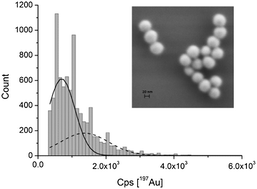Recently, first analyses of single sub-micrometre particles, embedded in liquid droplets, by inductively coupled plasma optical emission spectrometry (ICP-OES) with a size-equivalent detection limit of several hundred nanometres were reported. To achieve lower detection limits which might allow for the analysis of particles in the nanometre size range a more sensitive technique such as mass spectrometry (MS) is required. Various modifications of particle delivery and data acquisition systems commonly used were carried out to install a setup adequate for ICP-MS detection. These modifications enabled us to supply droplets generated by a commercial microdroplet generator (droplet size: 30–40 µm) with nearly 100% efficiency and high uniformity to the ICP. Analyses were performed using both standard solutions of dissolved metals at concentrations of 1 (Ag), 2 (Au), 5 (Au), or 10 (Cu) mg L−1 and highly diluted suspensions of gold and silver nanoparticles with sizes below 110 nm. In doing so, detection efficiencies of 10−6 counts per atom could be achieved while size-related limits of quantification were found to be 21 nm and 33 nm for gold and silver, respectively. Furthermore, the advantages of utilizing microdroplet generators vs. conventional nebulizers for nanoparticle analyses by ICP-MS are discussed.

You have access to this article
 Please wait while we load your content...
Something went wrong. Try again?
Please wait while we load your content...
Something went wrong. Try again?


 Please wait while we load your content...
Please wait while we load your content...